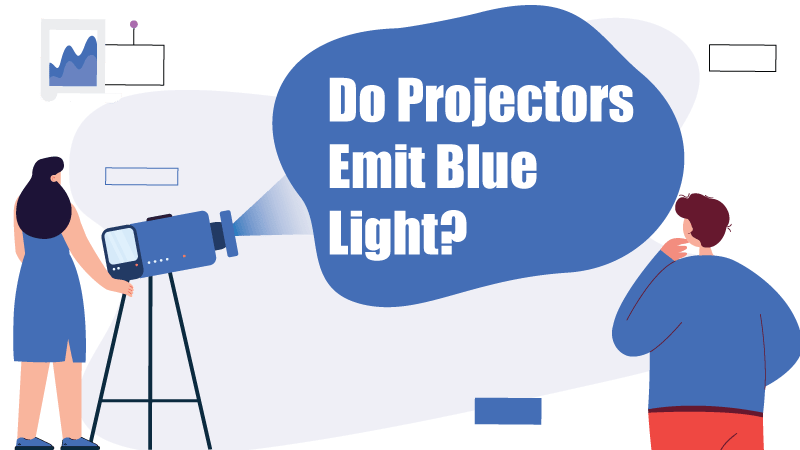Projectors are the most desirable and efficient way of presenting materials. For one, they take movie nights from good to super amazing. However, an important factor to consider when getting a projector is its threat to eye health. You heard it right; I am talking about blue light coming from your projector.

How do you view your projector?. Most people believe it’s cool to look directly into the projector’s screen with all the super bright light it emits. But, after a while, viewing becomes pretty uncomfortable.
Why is that? Like most screens, projectors emit blue light that could result in eye strain and, in the long run, serious eye damage if it falls directly on your eyes. To this end, great care must be taken to protect your eyes when choosing a projector.
What is Blue Light? Why is this a point of concern?
Look outside your window; the light you see is more complex than you think. What appears as visible white light is a spectrum of colors. It includes colors like Red, Orange, Yellow, Green, Blue, Indigo, and Violet. You may remember them from high school science with the acronym ROYGBIV.
Blue light is part of this spectrum with a very short wavelength and high energy. It ranges from 380 to 500mm and makes up about one-third of visible light. This means the naked eye can easily see it.
How Harmful is Blue Light? How can Blue light Affect Your Eyes?
In large amounts, short waved, high-energy waves like blue light can increase the chances of getting eye diseases. Research shows an increased production of toxic molecules in photoreceptor cells due to increased exposure to blue light. It also results in permanent vision changes and causes a retina disease called Macular degeneration.
Aside from the severe issues it causes in the eyes, blue light could also result in the following problems;
- Have you ever binge-watched a Netflix series until very late and found it difficult to sleep afterward?. Well, studies show that blue light messes with your sleep cycle. Too much screen time causes insomnia because it inhibits the production of melatonin, your body’s sleep hormone.
- In children, the stakes are even higher. Kids’ eyes don’t perform too well in filtering out blue light compared to grown-ups. This could result in Obesity, nearsightedness, and problems paying attention.
- Blue Light increases the risk of coming down with terminal illnesses like cancer.
- It’s always refreshing to wake up in the morning ready to face the day’s challenges after getting a good night’s rest. But on the other hand, too much exposure to blue light inhibits sleep, resulting in very dull and depressing days.
Solution:
If you can use your projector wisely and avoid direct eye contact with the emitting light, then a projector light will not damage your eye.
Note: A laser projector emits a lower amount of blue light than a normal projector.
How does blue light damage your eye?
Blue light is a wavelength of light found in our everyday natural sunlight and all artificial things that emit light. The blue light from the projector can be eye-damaging because of its high intensity. The range of its intensity is altered by its wavelength. This means the longer its wavelength, the lesser its energy of intensity, and the shorter its wavelength, the higher its energy of intensity. And blue light tends to have a shorter wavelength which makes its energy of intensity high.
When your eyes are exposed to this high intensity of light, due to its high and unfiltered intensity, it will pass through the top layer and hit straight into your retina, causing pain and sometimes severe damage. Prolonged exposure to blue light will lead to eye strain, fatigue, pain, and dry eye. Cumulatively this issue can cause damage to the retina cell, which causes degradation in vision.
So before bidding you goodbye, let’s take a quick look at certain safety measures to follow.
Safety Precautions to Adhere to Prevent Eye Damage While Using The Projector
Since projectors emit blue light, you must take some safety precautions to protect your eye and prevent any eye damage while using the projector. Here are some simple steps you can take.
- Make sure that you view the projector from a distance, as recommended by the manufacturer.
- Ensure to reduce or eliminate any source of ambient light
- Avoid staring directly into the lens as it emits a large amount of light from the small area.
- Some people do it for fun, opening up the projector while it’s still working without proper protection for their eyes. However, it is unsafe for you to open up the projector while it’s still functioning without proper protection for your eye because this particular action can temporarily or permanently damage your retina. As the light is unfiltered and the constant leakage of UV(ultra-violet) rays can cause eye burn followed by momentary blindness, so switch off the projector before commencing opening up the projector panel.
- Always use proper accessories such as an appropriate screen, good mounts, and other components to minimize any chance of exposure. Additionally, avoid sitting too close to the projector and maintain a preferable distance from the projector.
- It is always better to mount your projector in a place where you can prevent maximum eye contact.
- While providing a presentation, maintain a good distance from the light to protect your eye from getting affected by harmful rays.
- Lastly, follow the 20-20-20 rule by taking a 20-second break every 20 minutes and looking at something 20 feet away.
- Follow these safety measures properly and enjoy quality entertainment time with your friends and family.
FAQs: Frequently Asked Questions – Do Projectors Emit Blue Light.
What are the other sources emitting blue light?
I’m sure you are reading this article on a screen, be it a laptop or a mobile phone. That’s one major source of blue light. In fact, every form of visible light contains a percentage of blue light. Aside from electronic devices like smartphones, computer monitors, LED TVs, and tablet screens, other sources of blue light include sunlight, fluorescent light, light bulbs, etc.
What are rod and cone cells? How do they function?
Your eyes consist of two light-sensitive cells: rods and cones. The rod cell helps detect red, blue, and green lights. Without the rod, cell color will not be visible. While the cone cell plays a very important role in color vision, and from birth, you were born with at most 30 million cones, and it decreases as you grow older, which is natural, but with constant exposure and direct eye contact with blue cones tends to decrease more than expected. Blue light can also cause eye disease experienced in old age.
Do your eyes handle blue light the same way as UV light?
Your eye is equipped with structures that protect it from exposure to some light. The cornea and lens protect the light-sensitive retina at the back of your eye from damaging UV(ultra-violet) rays, but this structure can not protect your eyes from blue light, and you are exposed to a lot of it.
What light source emits the maximum amount of blue light?
The natural sunlight you are exposed to emits an exceeding amount of blue light than every other artificial source of blue light.

